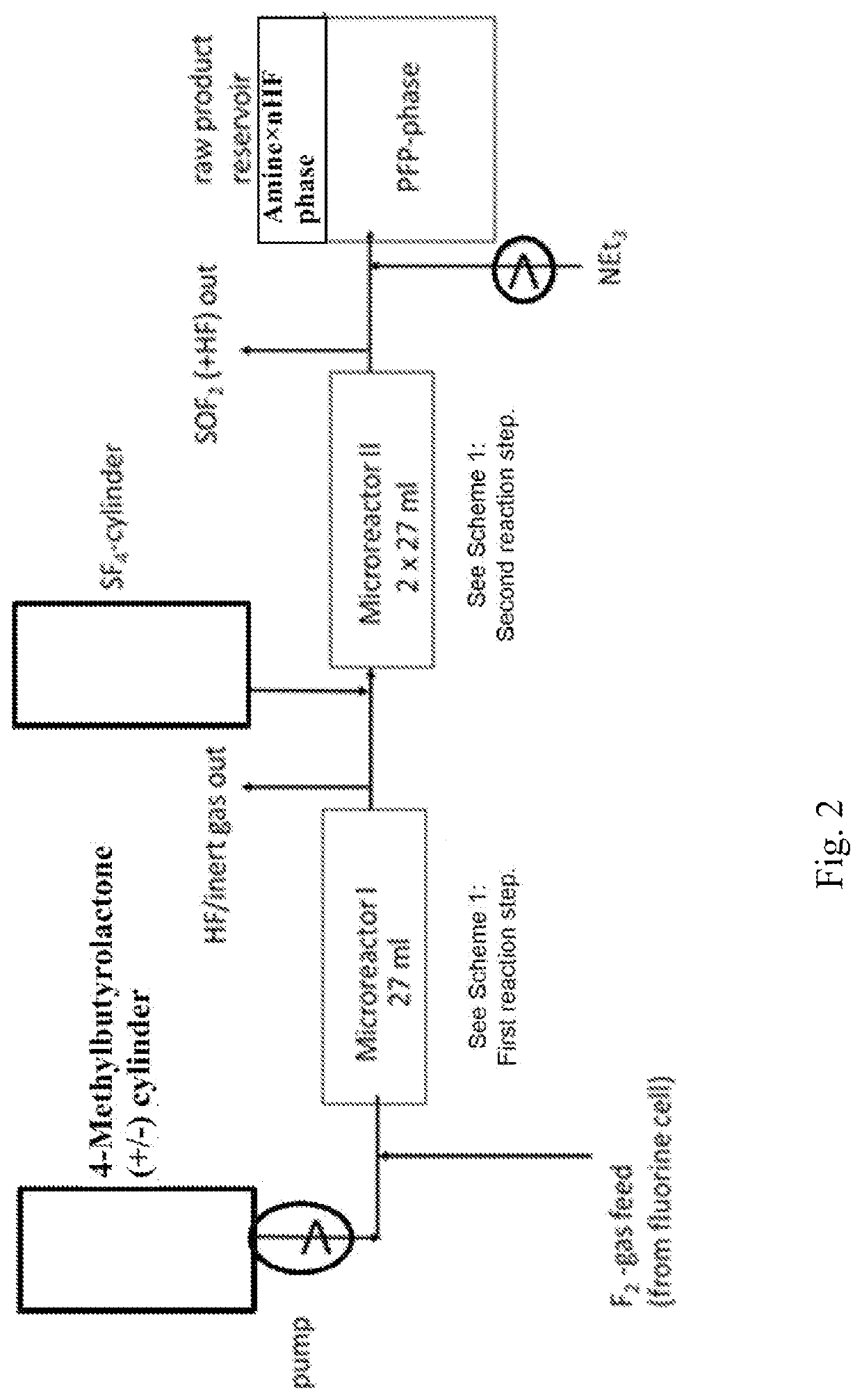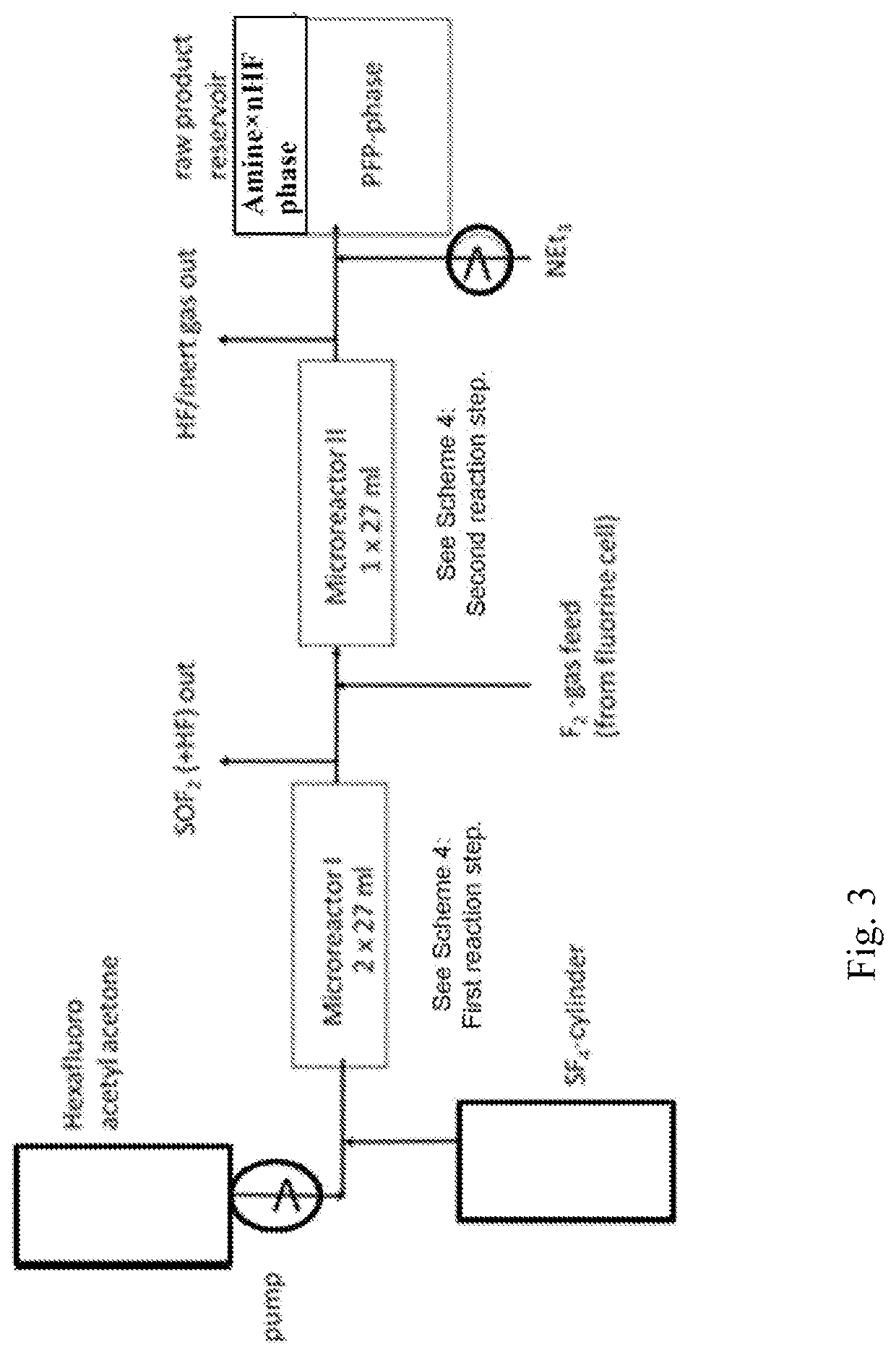Industrial Process for Manufacturing of Perfluoropentane (PFP)
a technology of perfluoropentane and industrial process, which is applied in the field of new industrial process for manufacturing of perfluoropentane (pfp), can solve the problems of inability to use human raw materials, inability to synthesis and final purification of perfluorinated compounds to an acceptable quality in general use, and high cost of raw materials due to electric power consumption. , to achieve the effect of reducing and simplifying the number of separation steps, avoiding time and energy consumption
- Summary
- Abstract
- Description
- Claims
- Application Information
AI Technical Summary
Benefits of technology
Problems solved by technology
Method used
Image
Examples
example 1
[0233]Both steps done in an autoclave:
[0234]A 250 ml Roth autoclave with HDPTFE-inliner (made by company Berghof Fluoroplastics), magnetic stirrer, deep pipe and outlet with pressure valve over the gas phase (with an efficient scrubber after the valve) was filled with 100 g (1.0 mol) 4-methylbutyrolactone (+ / −) and put into an ice bath. 20% F2 (80% N2) was fed out of a gas cylinder over the deep pipe at room temperature into the autoclave, the pressure valve was adjusted to 5 bar while N2 and formed HF were leaving the autoclave together. The F2-dosage was done in that manner that the temperature in the autoclave did NOT exceed 40° C. After 4 h, no exothermic activity could be observed any more. Based on the 20% F2, 380 g (10.0 mol) F2 were consumed until the exothermic activity has significantly dropped down. Stirring was continued for 1 more h at 5 bar pressure. The autoclave was not degassed to make sure that HF has stayed as solvent for the next step in the solution. The pressur...
example 2
[0235]Both steps done in a Batch synthesis and in a loop reactor.
[0236]Apparatus: A column with a length of 30 cm with PTFE fillings and a diameter of 5 cm was used according to the drawing below. The liquid reservoir had a volume of 2 l. The pump was a centrifugal pump from company Schmitt. A pressure valve on top of the tower was installed to regulate the pressure, a cooling trap was installed after the pressure valve which was in use for the 2nd step only to collect some PFP leaving with the gas stream.
[0237]See FIG. 1 for apparatus and reaction.
[0238]The reservoir was filled with 1 kg (9.99 mol) 4-Methylbutyrolactone (+ / −) and the pump was started (flow ˜1500 l / h). 10% F2-gas (in N2) was fed over a Bronkhorst mass flow meter into the tower so that the reaction temperature was kept at 30° C. while the pressure on the tower was kept at 2 bar abs. by the pressure valve. After 1 h 3.04 kg (80.0 mol) F2 were fed into the system while the inert N2 together with HF left the apparatus o...
example 3
[0239]Continuous preparation of PFP in microreactor system
[0240]See FIG. 2 for apparatus and reaction.
[0241]One 27 ml Microreactor from Chemtrix made out of SiC was used for the 1st step, 2 in series connected 27 ml microreactors were used for 2nd step. All 3 microreactors were operated at 30° C., the pressure after 1st microreactor was adjusted to 5 bar by using a pressure valve installed at HF / inertgas outlet at the cyclone, which is not shown in the drawing. Pressure after 2nd microreactor is adjusted to 2 bar abs. by a pressure valve installed at SOF2 outlet at another cyclone, which is also not shown in the drawing. The raw material reservoir contains a double wall jacket and is cooled to 0° C. 100 g (1.0 mol) 4-methylbutyrolactone was fed together with 323 g (8.5 mol) F2 directly from a fluorine cell additional diluted with 10% N2 over a Bronkhorst mass flow meter and over 1 h into the 1st microreactor, a very strong exothermicity was observed so that a cooling machine (−20° C...
PUM
| Property | Measurement | Unit |
|---|---|---|
| natural abundance | aaaaa | aaaaa |
| natural abundance | aaaaa | aaaaa |
| melting temperature | aaaaa | aaaaa |
Abstract
Description
Claims
Application Information
 Login to View More
Login to View More - R&D
- Intellectual Property
- Life Sciences
- Materials
- Tech Scout
- Unparalleled Data Quality
- Higher Quality Content
- 60% Fewer Hallucinations
Browse by: Latest US Patents, China's latest patents, Technical Efficacy Thesaurus, Application Domain, Technology Topic, Popular Technical Reports.
© 2025 PatSnap. All rights reserved.Legal|Privacy policy|Modern Slavery Act Transparency Statement|Sitemap|About US| Contact US: help@patsnap.com



